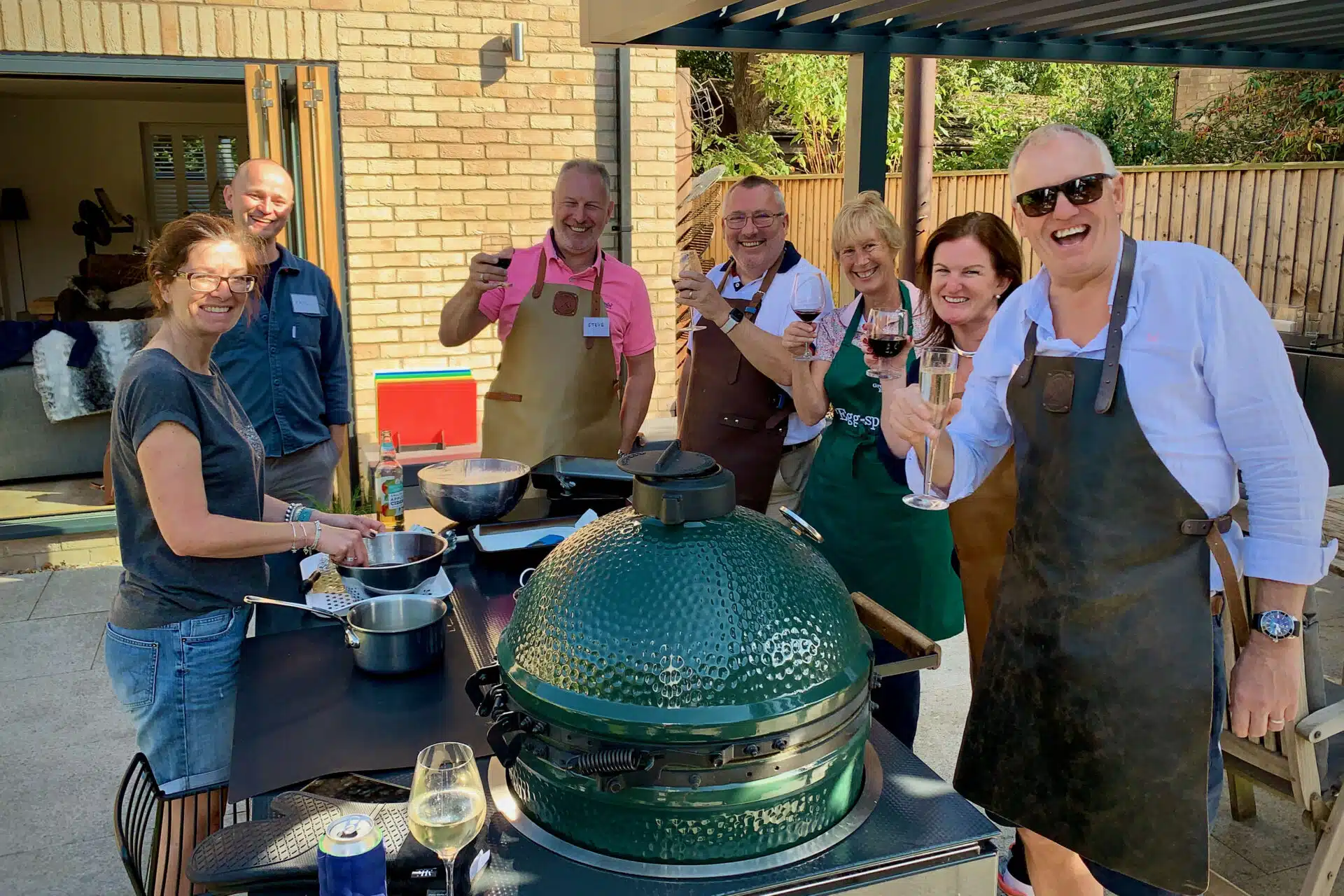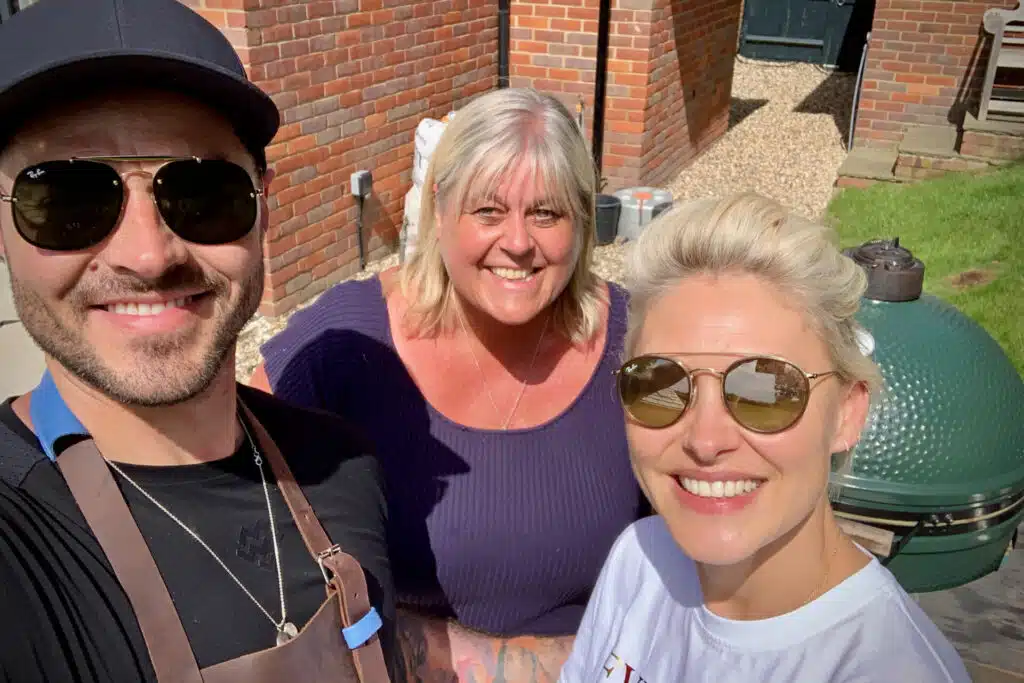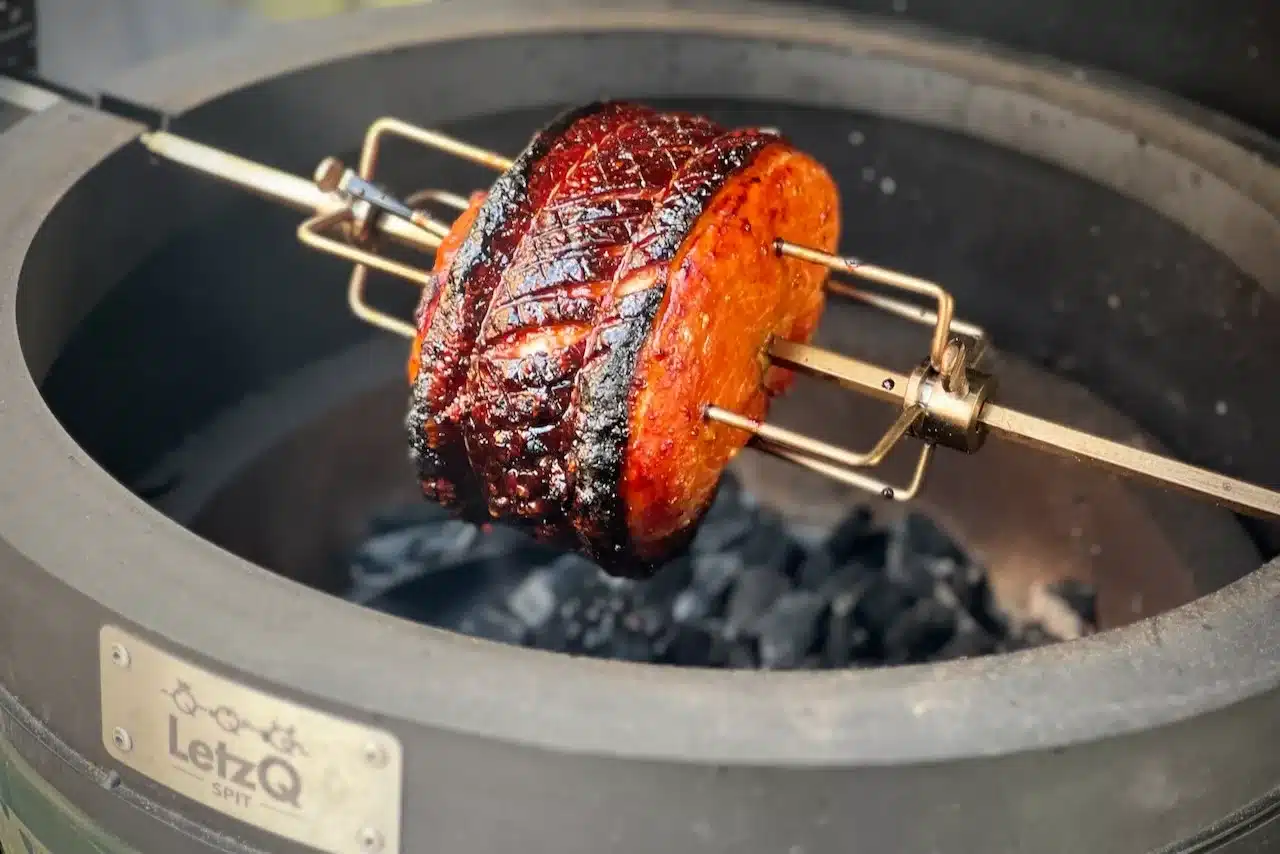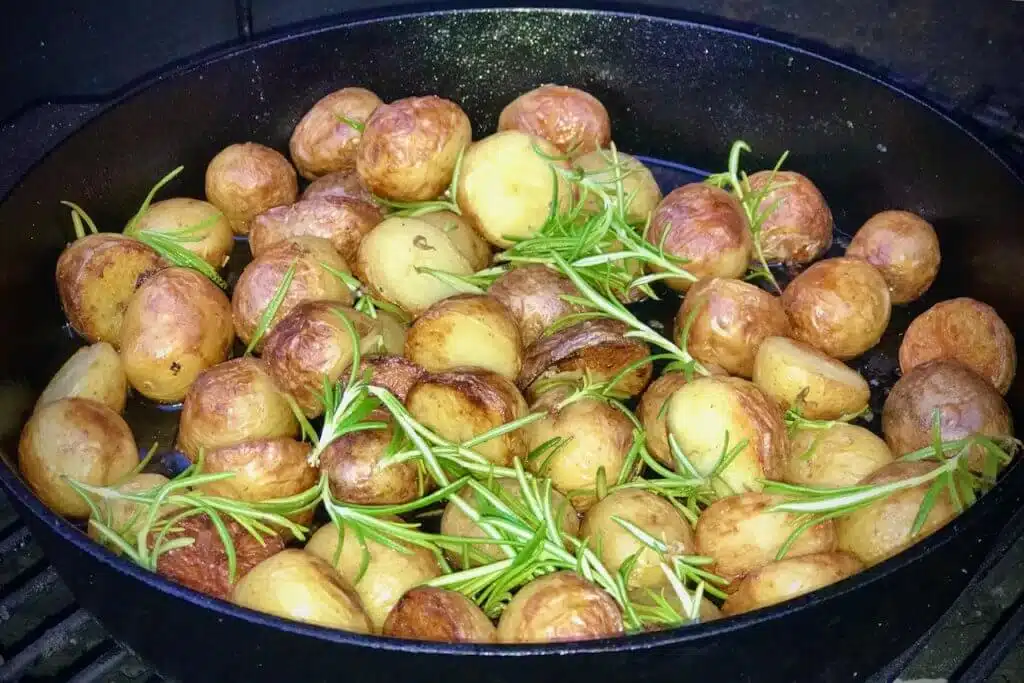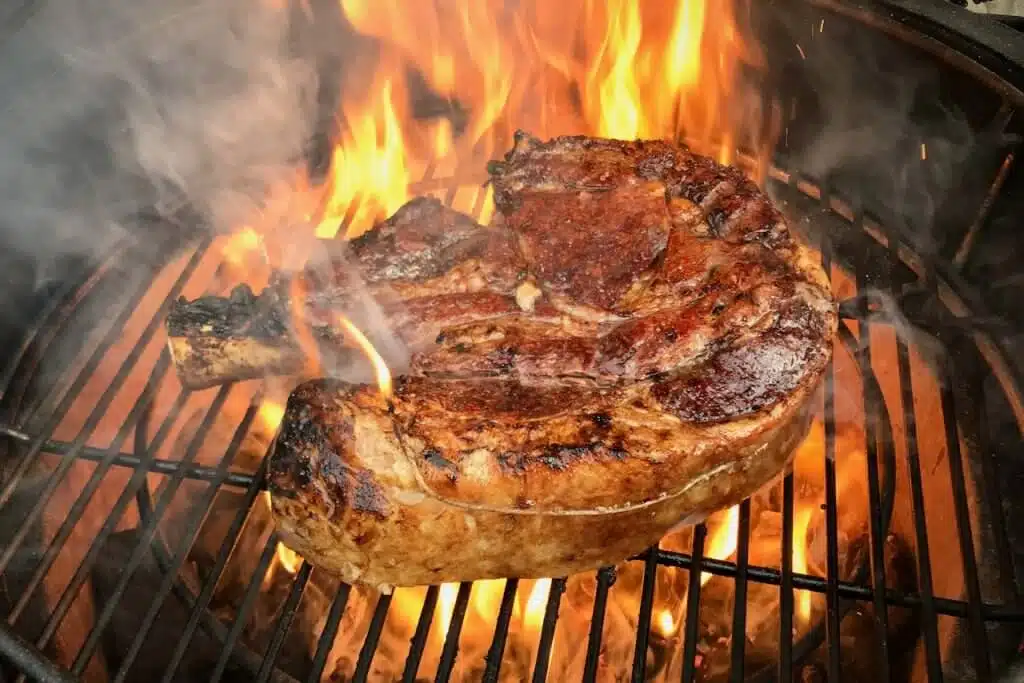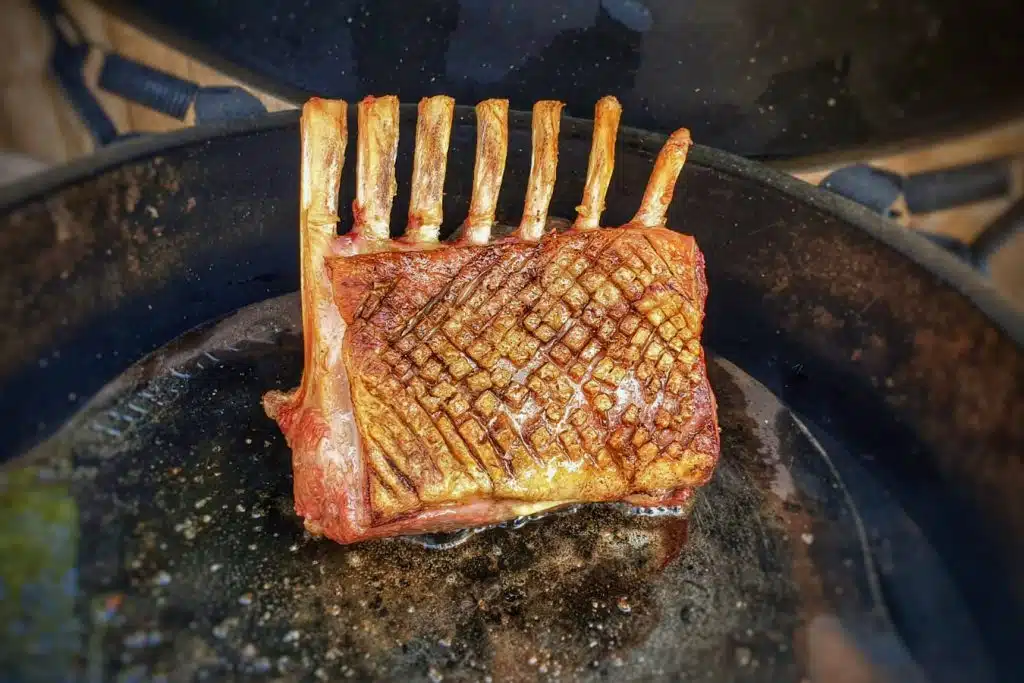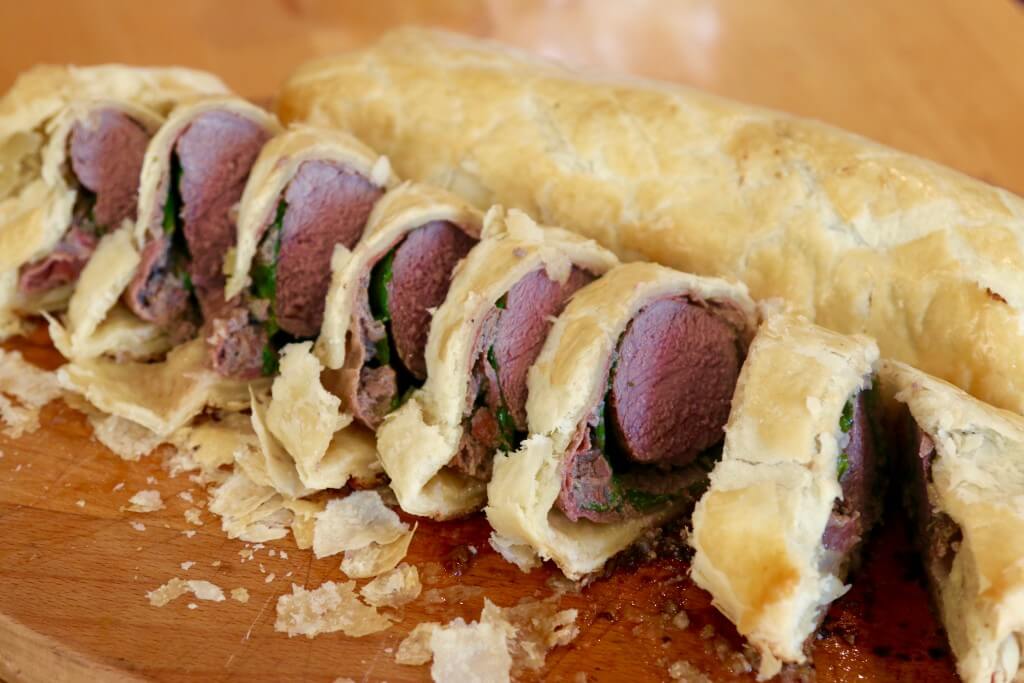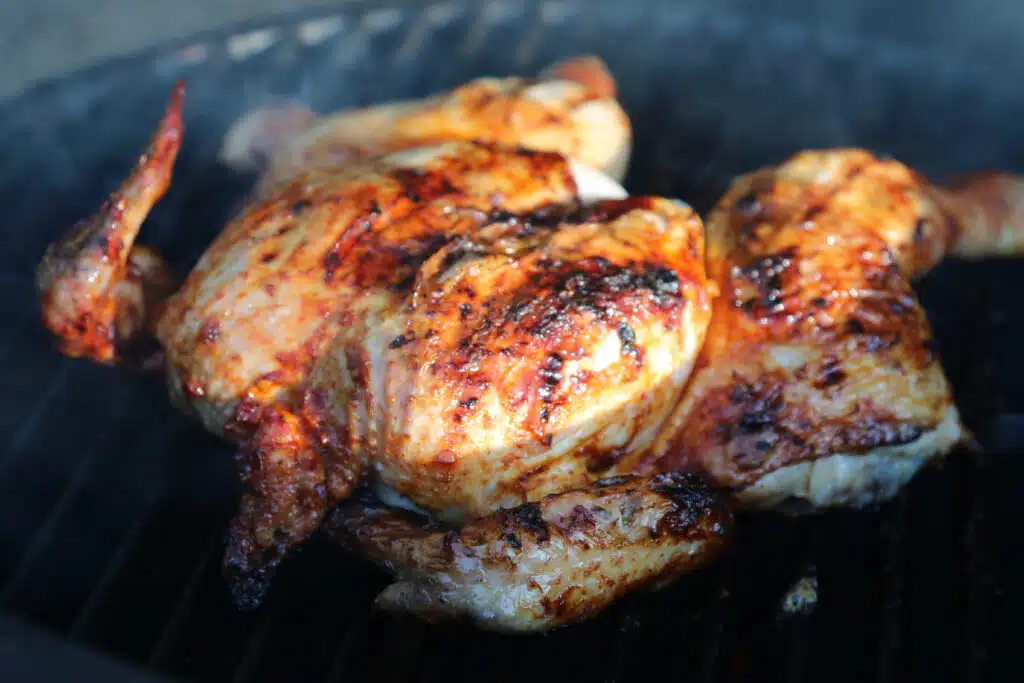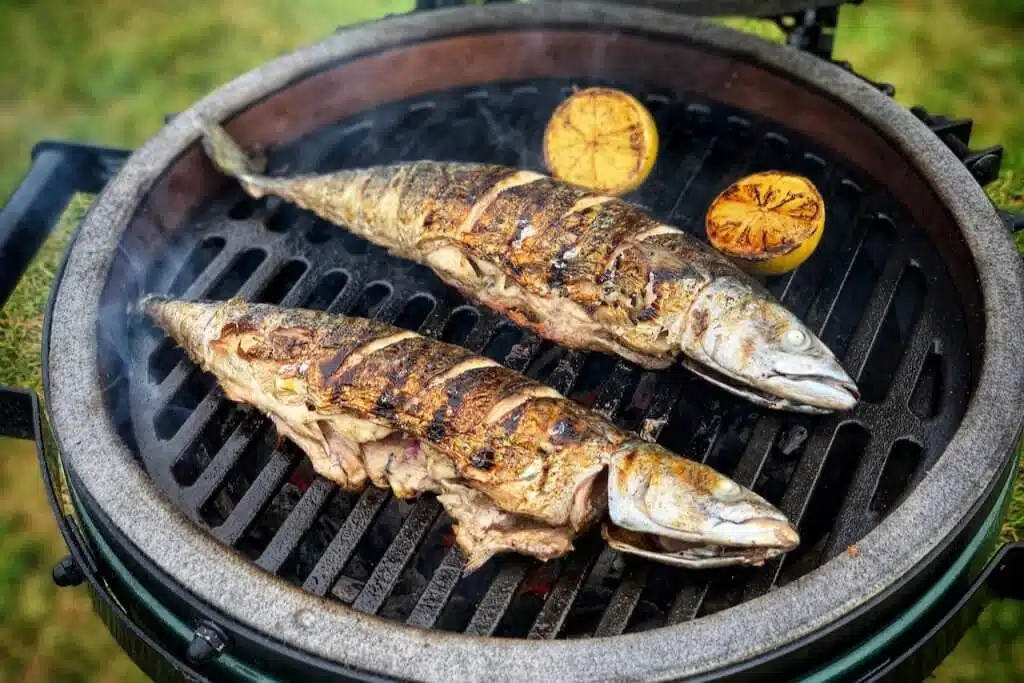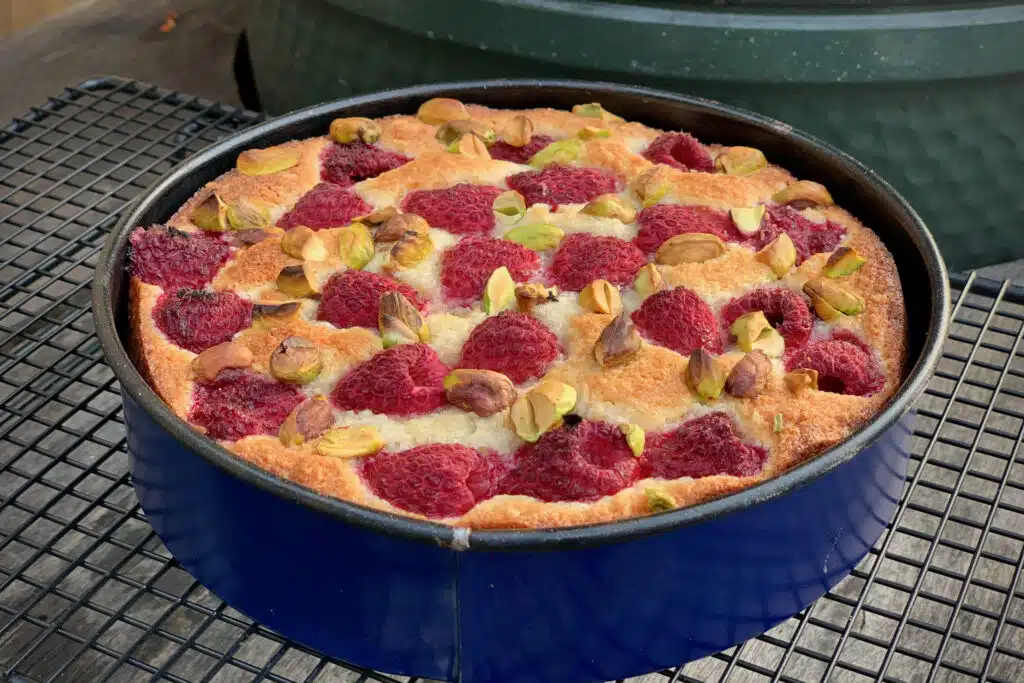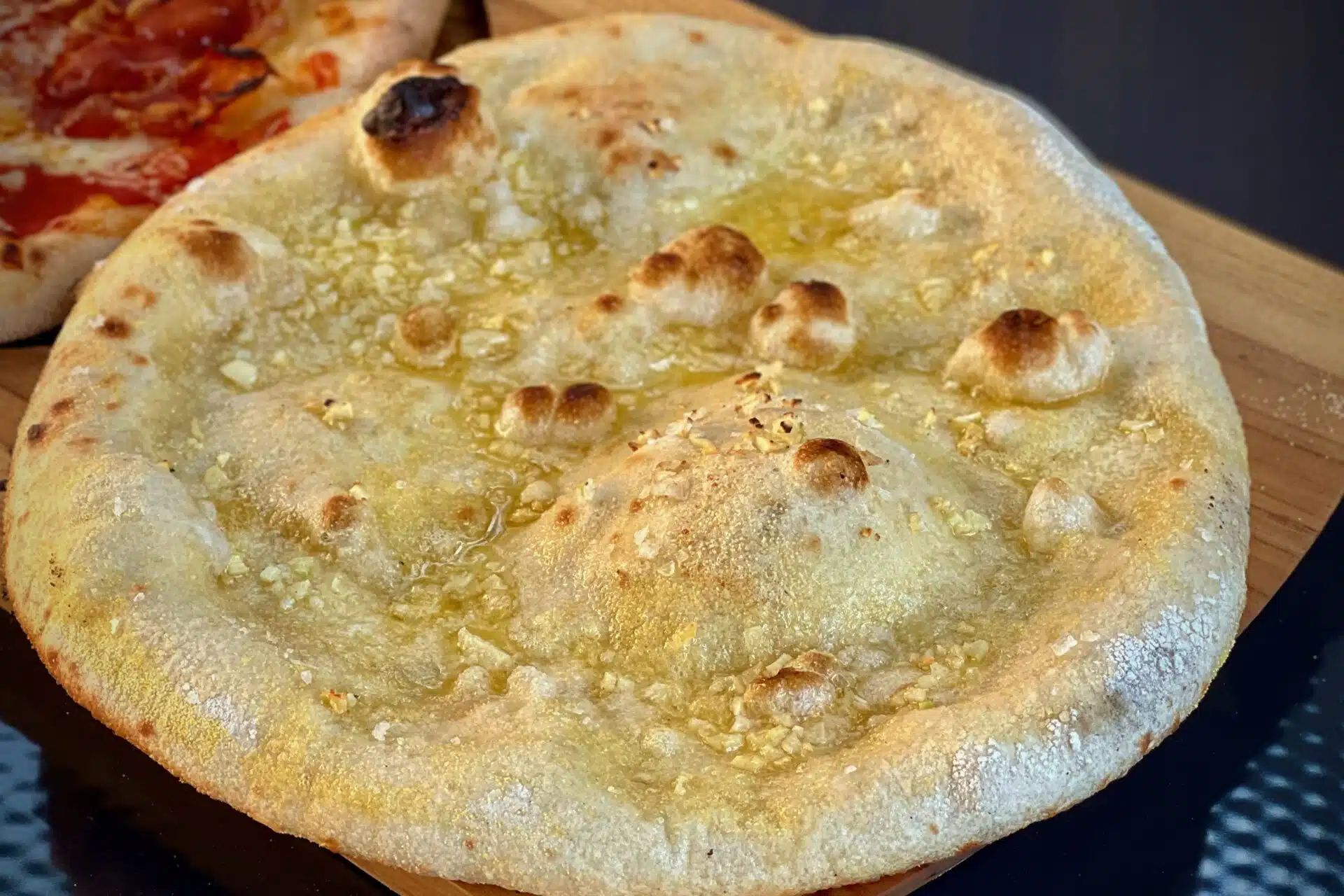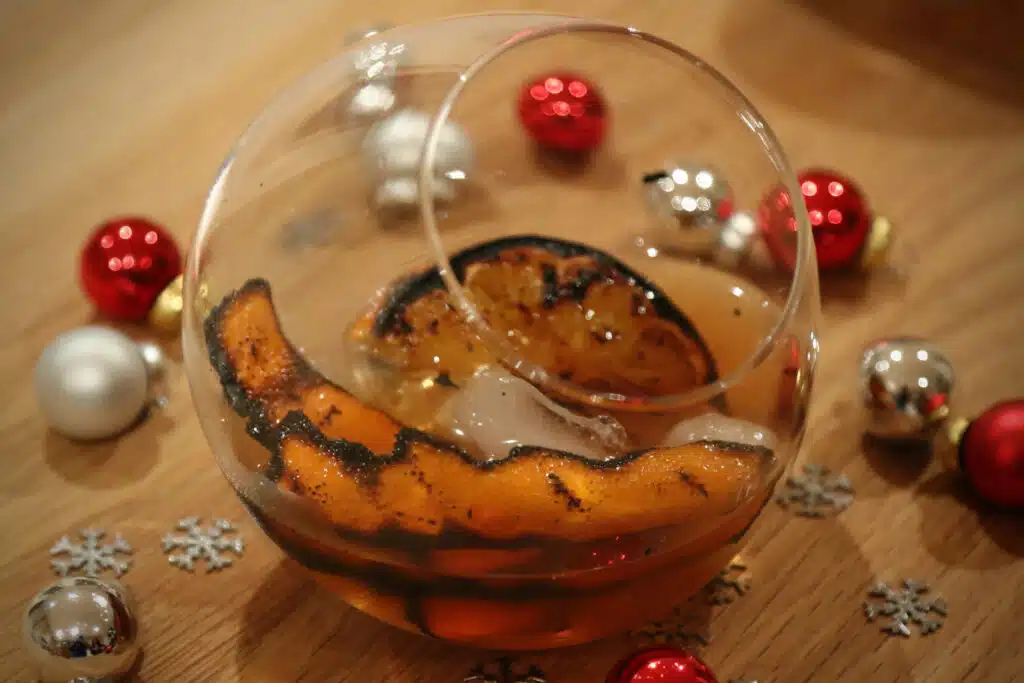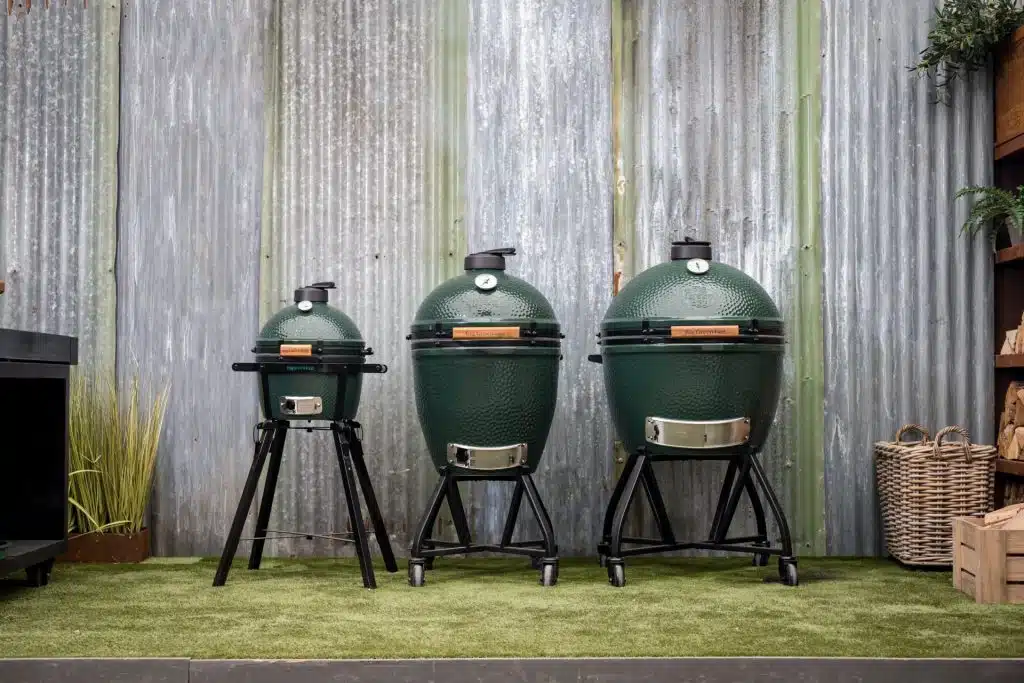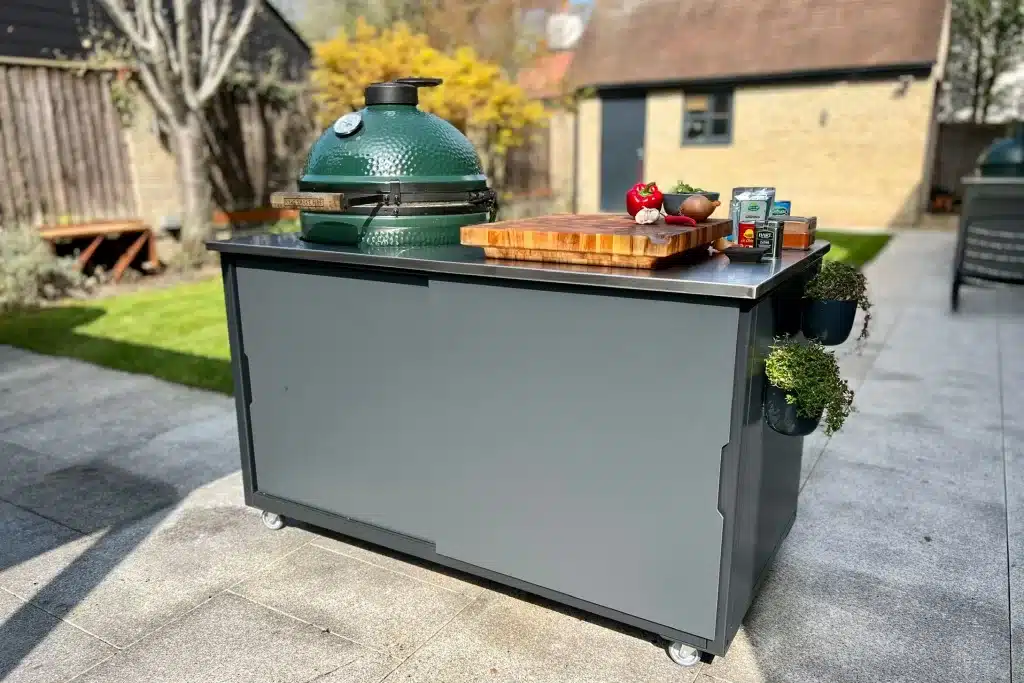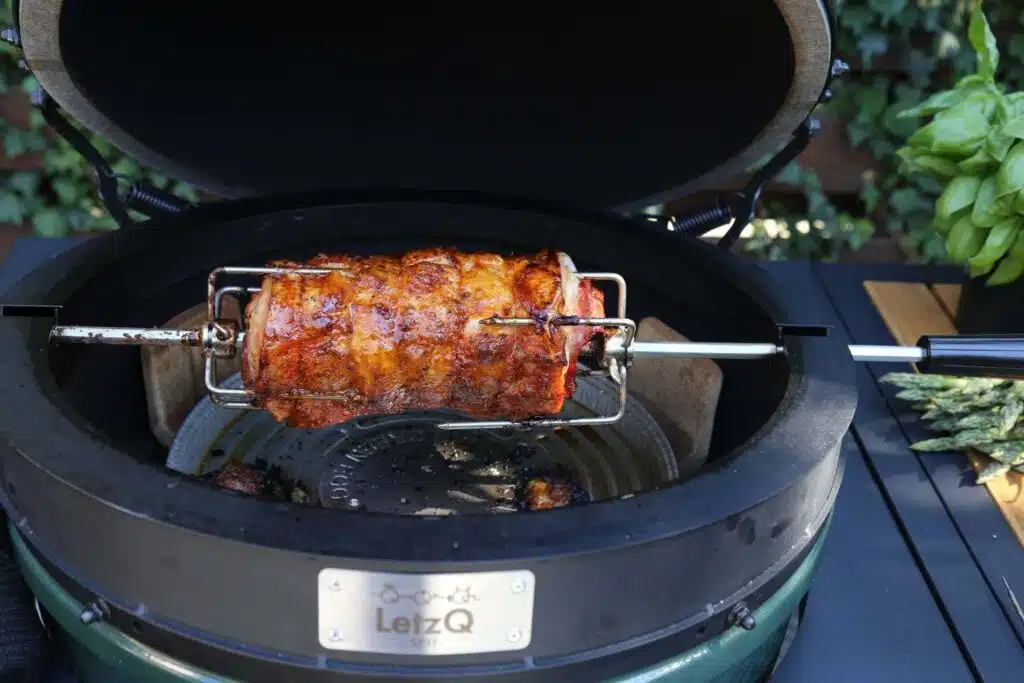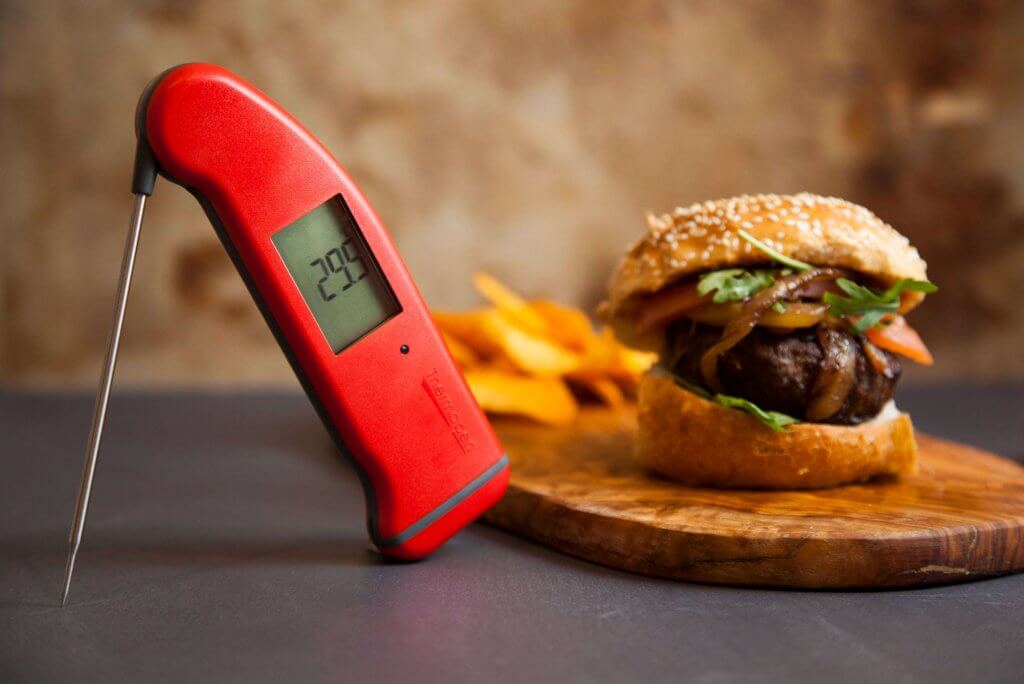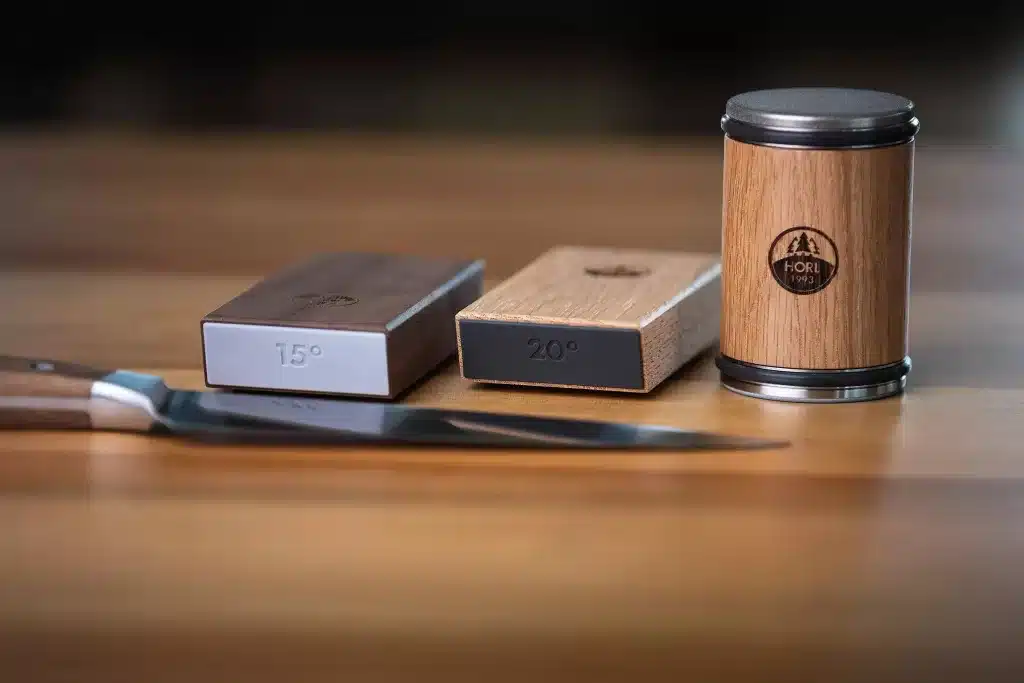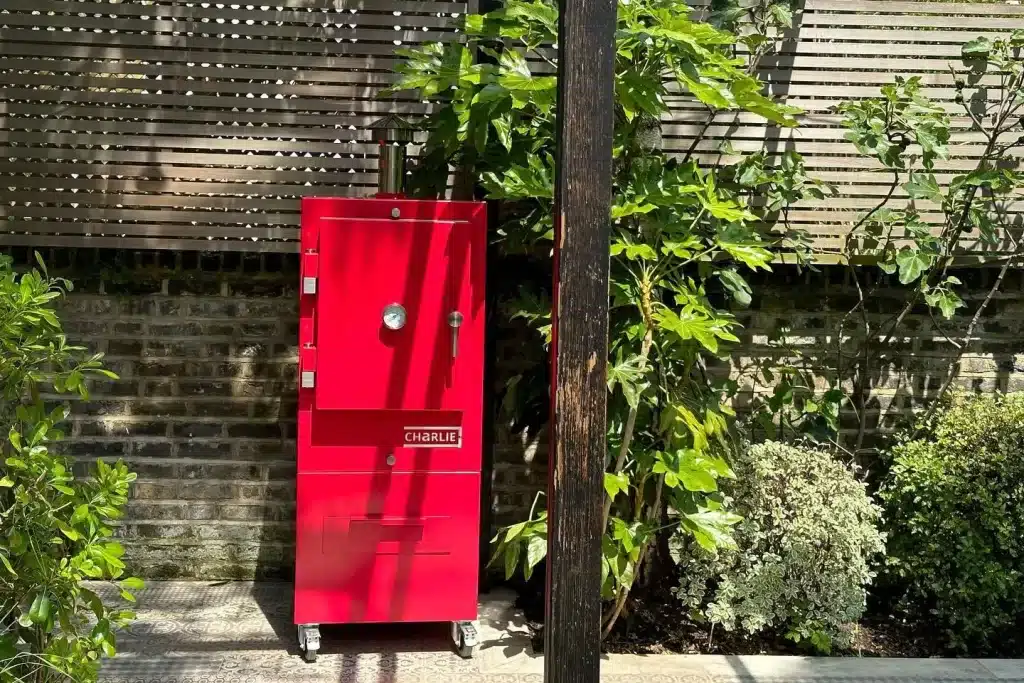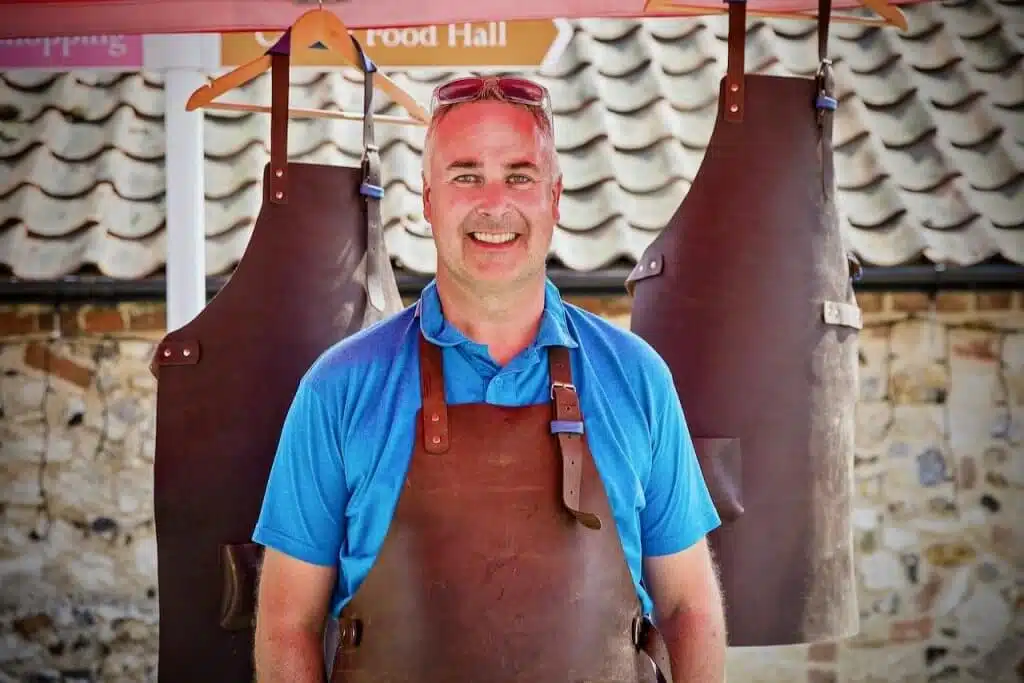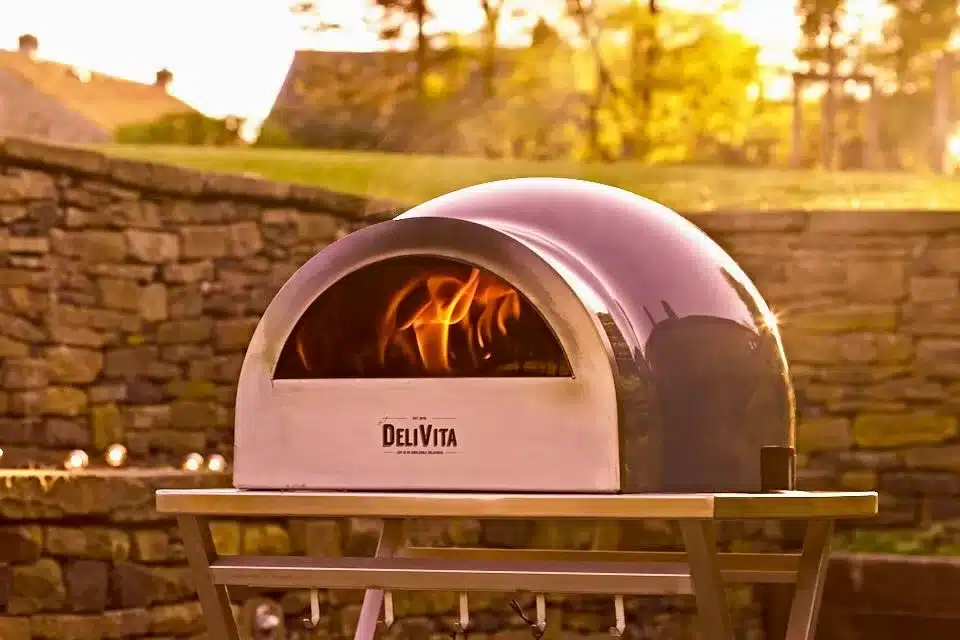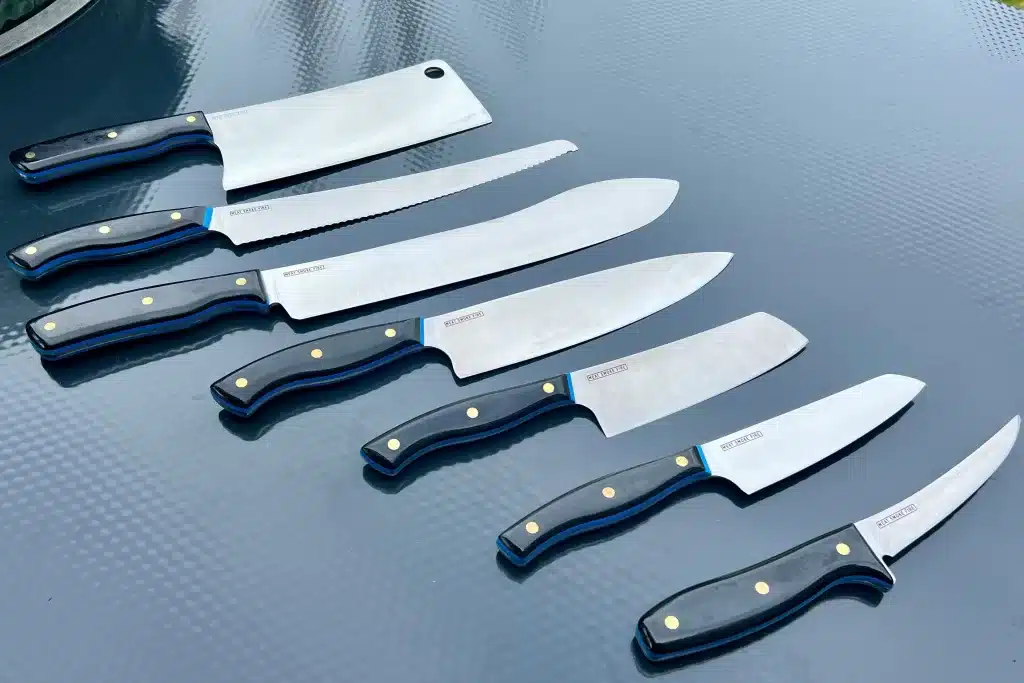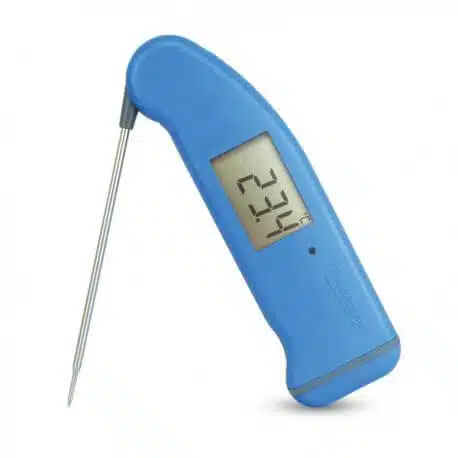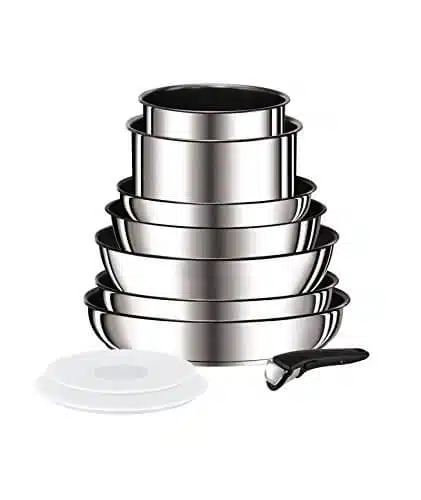Big Green Egg Class at The Gog
These are the links to the recipes we cooked:
- Slow roasted lamb shoulder
- Steak 3 ways – cast iron grid, cast iron pan and dirty
- Korean Chicken Thighs – the recipe is for wings but we used thighs.
- French Trimmed rack of lamb – the recipe is for my plancha cooked racks of lamb. At the class we reverse seared it.
- Vegan Coconut Flatbreads – I used a recipe from another site and cooked these directly over the charcoal, turning once.
Questions and Answers
What's the best cooking temperature for steak?
I prefer to cook steak between 250°C and 300°C. I use the lower of the two temperatures for thicker steaks and the higher temp for really thin steaks where I want a very fast sear.
My three favourite ways of cooking steak are:
- Dirty – cooked directly on the charcoal
- Seared – cooked on the cast iron searing grid to give the steak a criss-cross finish
- In a cast iron pan – this will give a crust over the whole of the steak.
All three are great methods so give them all a go and find your favourite.
How much longer does it take to cook a chicken in the Egg?
Because you are able to set the temperature of the Egg just as accurately as you can in the oven, the chicken will take pretty much the same time. It will however be far more moist and have a nice BBQ flavour.
How do I get crackling when I'm cooking pork?
The key to crackling is to start with first class pork. Avoid vacuum packed pork from supermarkets or even bad butchers, you want the skin to be dry, not soggy.
I leave my joint uncovered in the fridge overnight, this will dry the skin even further. When you’re ready to cook, pour boiling water over the scored skin, pat it dry and then coat with olive oil and maldon salt. Rub the salt into the scored skin.
Cook your joint on the Egg. For belly pork I cook it skin side down. Towards the very end of your cook, if it hasn’t already crackled, turn your Egg up to 220°C and let it crackle the skin. It will do this in 15 mins. Keep checking it to make sure it’s not burning.
Rest your joint loosely foiled.
Is bacon processed meat?
The process of turning pork belly or loin into streaky or back bacon is the process of curing. To cure a piece of meat you salt it to draw out the moisture, leaving the meat with a moisture content too low to support bacteria. You can do this with just salt. However it is safer to use a curing salt that will have added nitrites. The nitrites perform two tasks, preventing botulism and also leaving the colour of the bacon pink. With just salt the bacon would turn brown.
The levels of nitrites within the cure are so low they should pose practically no risk.
I therefore don’t consider bacon as a processed meat. Live a little.
Are there any Big Green Egg Cooking Books?
Big Green Egg do have some cooking books. They’re actually cheaper on Amazon than from Big Green Egg:
- Big Green Egg Cookbook: Celebrating the Ultimate Cooking Experience
- Big Green Egg Cookbook: Cooking on the Big Green Egg
- Ray Lampe’s Big Green Egg Cookbook: Grill, Smoke, Bake & Roast
Having said that I don’t rate any of them. The recipes aren’t ones you are going to want to go back and do over and over. You’re much better off using recipes you can find on the web including this site.
Do you use the top or bottom vent to control the temperature?
See my page on setting the temperature on your Big Green Egg.
I don't like my steaks bloody
The liquid coming out of cooked meat is NOT BLOOD. If blood was present it would have coagulated shortly after the slaughter and turned black. What we see is water and a protein called myoglobin. Myoglobin turns brown when heated, it stays red when it’s cooler. It’s this you are seeing. The only difference therefore between a rare steak and a well done steak is the amount of water you’ve evaporated and the colour of the myoglobin. A well done steak is less juicy.
There’s a great website that covers a lot of this science. Have a good read of AmazingRibs.com and start with the basic science behind cooking.
Do I use wood chips or chunks and do I soak them in water?
- Change charcoal brands to something to suit your cook. See the next section about different charcoals. Some people will switch charcoal to a type to match their cook and then only use charcoal to get the flavour they are after.
- Use chips – when you are doing shorter cooks you will get more smoke from chips.
- Use chunks – ideally suited to longer cooks where you want smoke for a slightly longer period.
Remember meat takes on smoke when it is cooler and wetter. Therefore you need the smoke at the beginning of the cook. Therefore place your chips and chunks towards the centre of your Egg where the charcoal will be burning at the beginning of the cook.
Be sparing with your chips and chunks. I use less than a handful of chips and maybe just two chunks. Start light and build up to the level of flavour you want. A lot of people overpower their food with the smoke flavour, ruining it in my opinion.
Which Charcoal should I use?
The Green Olive Firewood Company do charcoal that has a much milder smokey flavour. It’s made from SheOak. You need their restaurant grade lump wood charcoal.
Stag Charcoal also produce some great stuff in Hertfordshire. Look for their single species Ash or Birch for a less smokey cook.
When you really get into BBQ then look at some of the excellent charcoal from the Oxford Charcoal company. They have a very good reputation for their single species charcoals. They have a great chart on matching wood to meats and fish.
Can I use my Egg undercover or indoors?
You should always use your Egg in a well ventilated area. However that doesn’t stop you using it under a parasol or roof. The amount of heat coming out of the top, even during lighting won’t burn a parasol in my experience. Open sided shelters are perfect.
Cooking indoors though isn’t recommended. You’ll see restaurants doing it but they have very powerful commercial ventilation systems and safety measures to make sure they don’t poison themselves. An Egg will produce carbon monoxide, which can kill if not ventilated properly. I would never recommend using an Egg indoors. As my wife always says, ‘you only need two accessories to cook outside all year round, an umbrella and a glass of wine’.
What Thermometers do I recommend?
You’d have heard me say several times in the class that I cook by temperature and not time. In order to do this you need a thermometer or two.
A Thermapen is my essential tool. That’s why I had my aprons designed with a Thermapen pocket. I wouldn’t be without mine. I personally sell the latest version as it’s waterproof and backlit. It’s so good I have one for classes and one for home use. Cheaper alternatives aren’t as accurate and don’t read temperature anywhere near as quickly, I therefore don’t use them.
The other Thermometers I showed you were the Meater, the wireless probe I used to cook the chickens and the pork. I am now a dealer of these and you will be able to buy the Meater+ in my shop. The block (4 probes) is still not available to the public and might not be until late summer. I may or may not stock this when it is available.
Which way up do I put in the Plate Setter (or ConvEGGtor)?
How do I light my Egg?
- Top up the Egg with new charcoal to just above the line where the fire bowl and the fire ring meet.
- Create a small indentation in the centre of the charcoal and put in just one lit fire starter.
- Cover very loosely the fire starter with a few pieces of charcoal, you need to allow a good airflow.
- Leave the lid open and open the bottom draft door. Leave your Egg for 10 minutes to allow the middle of the charcoal to get going.
- After 10 minutes, close the Egg lid and open the cast iron top fully. Remember to position the screw towards you.
- Leave the Egg closed for about 5 minutes until it hits 180°C and has started warming the dome.
- You can now adjust your Egg to the temperature you want to cook at. See my temperature guide.
Do take a look at the Big Green Egg Tips Series. This video covers lighting your Egg,
What is a dirty steak?
A dirty steak should only ever be cooked on lump wood charcoal or burning untreated wood. Never make one on briquettes, your steak will end up being covered in the gritty material they are manufactured from.
What temperature do you cook steaks at?
I cook thinner steaks at a hotter temp (300°C) while doing much thicker steaks at a lower temp (250°C). If my steaks are thicker than 1.5inches, I will then consider doing a reverse sear as we did with the picanha.
Do you need to turn steaks?
Why am I having issues lighting my Egg and getting the temperature up?
- Fuel – lump wood charcoal
- Oxygen – air
- Heat
If you’re struggling to get the Egg lit and up to temperature fast it’s likely to be one of these three things lacking. Causes could be:
- Your charcoal is damp, make sure you always keep it inside out of the rain and dew.
- There isn’t enough airflow:
- You may need to clean your Egg. I recommend taking the ash out of your Egg every 5 or 6 cooks using the ash tool and doing a total clean, lifting the ceramics out, every 12-15 cooks.
- The charcoal you are using has too many smaller pieces, these will block the airflow.
It’s good practice to keep your Egg clean.
Cleaning your Egg
- Every cook – rake the left over charcoal from the previous cook and let it fall down into the bottom of the Egg.
- Every 5 or 6 cooks – clear the ash from the bottom of your Egg using an ash tool. If you are going to hoover it out, make sure the ashes are cold, I have a customer who set fire to her Henry vacuum cleaner because the ash was still hot the following day.
- Every 12-15 cooks – lift out all the internals of your Egg and give everything a brush down with a dustpan and brush.
Is there any advantage to making sauce in the egg?
Treat your charcoal as one of the ingredients of your cook.
When do I cook direct vs. indirect?
Obviously some things could be done either way, sausages for example. It’s the same inside, sausages can be cooked in a pan or baked in the oven.
When do you start timing a cook, when you put the meat in or when the Egg has got back to temperature?
I always have a Thermapen handy to check the temperature. I also use the Thermoworks Smoke when doing longer cooks as I can leave this attached to the Egg and a probe in the meat. I can then monitor the cook from the other end (like a baby monitor).
How do you know which meat needs what temp?

How long does the pizza stone take to heat up?
When cooking pizza I prefer to have the plate setter feet up, the stainless grid on top and then the baking stone. The gap between the plate setter and the pizza stone will stop the pizza stone getting too hot and burning the bottom of your pizza base before the top is cooked.
Do you ever wash the equipment?
Never wash any of the cast iron parts or the ceramic parts. Washing the cast iron will cause it to rust. Ceramic is porous and would soak up the water and could then cause damage to your Egg if it was heated rapidly, turning to steam.
To clean your Egg just turn it up to 350°C and it will burn off all the fats. Just wait until any smoke has stopped and you’ll find everything is clean.
I keep all my cooking surfaces and the metal daisy wheel inside the Egg, it’s the best place for them. You can put them straight in after a cook, even with the Egg hot.
Can you cook on higher temp for shorter time?
What's the difference between loin and sirloin?
Equipment
Thermapen
If there is one tool you have then I recommend it be the Thermapen. These handheld probe thermometers will transform the way you cook as you’ll know when something is ready rather than having to guess. I use the MK 4 version as it’s waterproof and has a backlit display that rotates so it’s always easy to read. You can buy them direct from my site. Either way they will be shipped direct from ETI, the UK manufacturer.
Meater+
I used the block version of this during the class. Unfortunately it’s not going to launch until the summer. I love the Meater+ as its app will estimate when your meat will be cooked and tell you when to take it off your Egg so that it doesn’t overcook. I wouldn’t be without a Meater.
They are now available to buy in my store and I hold stock of these. Use discount code CLASS10 at the checkout.
Tefal Ingenio Pans
I used these during the class to cook the sauces for the wings and for the pizza. They have removable handles and are really solid. I wouldn’t be without mine.
You can get them from Amazon using this link.
Bad Byron’s Butt Rub.
We’ve been using this rub at Big Green Egg in the UK as long as I have been working there. It’s not too sweet unlike the majority of the other rubs on the market, in fact it doesn’t contain any sugar at all.
We use it on pork and beef.
You can get it from Amazon using this link.
Leather Aprons
I’ve designed and had made my own Meat Smoke Fire branded leather aprons with a Thermapen pocket. They’re available in my online shop.
